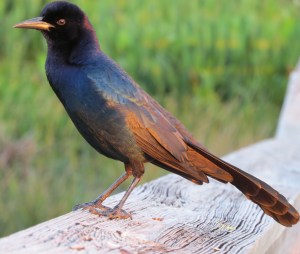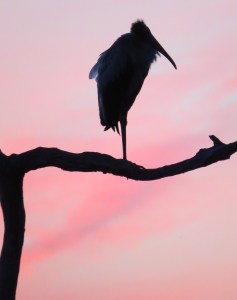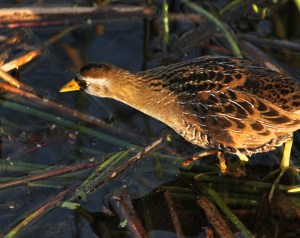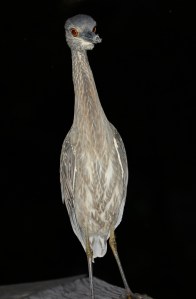It’s interesting to observe how the colors of the late day sun affect a bird’s appearance. The Red-Bellied Woodpecker above that I spied on a recent early evening walk, certainly looked like he was enjoying the last rays of sun.
We usually see the Boat-tailed Grackle above in his brilliant, shimmering blue feathers in the daytime sun. But yesterday, his feathers were transformed into a rust color in the waning sunlight. Frankly, he looked like he’d just accidentally fallen into a paint can!
Less than an hour after I saw that Grackle last evening, the deep pink sunset created a dark silhouette of this Wood Stork posing on one leg on a tall crag.
The Limpkin, tinted orange by the diminishing light at dusk, was squawking away as usual, and probably looking to impress his peers. He does a great job of making his presence known, as anyone who has a Limpkin as a neighbor can attest!
One of my favorite sightings this spring was the delightful little Ovenbird, who would always appear on my evening walks. I’ve never managed to get a really good photo of him in the dark and secluded little wooded area he frequented. He is a master of camouflage with his multi-colored body, and orange head stripe – he blends right in as he hops about on the forest floor among the leaves and twigs.
Since I often walk in the evening, and can’t bear to leave till it is literally dark (!), this seems a logical blog post in which to include (below) some other photos-in-the-almost-dark that I’ve taken of my wetland friends.
Have a nice evening~!!










Great pics!
LikeLike
The Limpkin is an interesting bird I have not seen before, I think it is known as the crying bird. Does it show breeding plumage?
LikeLiked by 1 person
Thanks, Aussiebirder! Yes, the Limpkin does sound like a human in distress at times – and it’s sometimes known as the Crying Bird. Honestly, I think the Limpkin’s eerie, piercing cry causes distress in humans if they’re close to an open bedroom window! I personally can’t see any obvious differences in their coloring during courtship, and males and females both work on nest-building and childcare :). I guess there are some behavioral differences, though, and the Florida Fish & Wildlife folks say, “Courtship feeding of the female by the male imitates an adult feeding a juvenile”.
LikeLike
There are number of birds, including the Fairy Tern, where courtship involves the male catching a fish and presenting it to the female. If she accepts he gets to mate and she eats the fish in front of him. 🙂
LikeLiked by 1 person
Fascinating – I didn’t know that! Thanks for sharing that cool tidbit.
LikeLike
This is a great bird gallery, Love it! Wood Stork is an awesome shot, the Ovenbird is so cute…
LikeLiked by 1 person
Thank you for your visit and your kind words, Amy! Yes, that little Ovenbird was a first for me – hope we see him again next year.
LikeLike
Beautiful images. It’s a joy to hang around as the light starts to fade, but a real challenge to getting good photos. You managed to capture quite a nice assortment of interesting birds.
LikeLiked by 1 person
Thanks, Mike. I’m fortunate to have an amazing variety here in our local preserves. And someone is always out and about, no matter what time it is!
LikeLiked by 1 person
I get out infrequently in the evening, but so much like photos of the birds at that time – like you have shown. The colors are different and many times just a bit dreamier. Lovely photos.
LikeLiked by 1 person
Thanks for visiting and sharing, Donna!
LikeLike